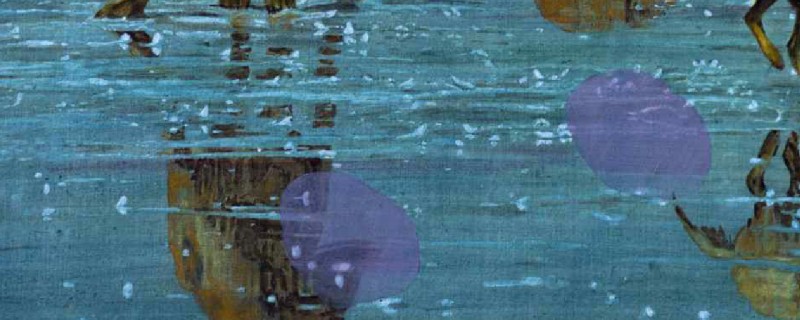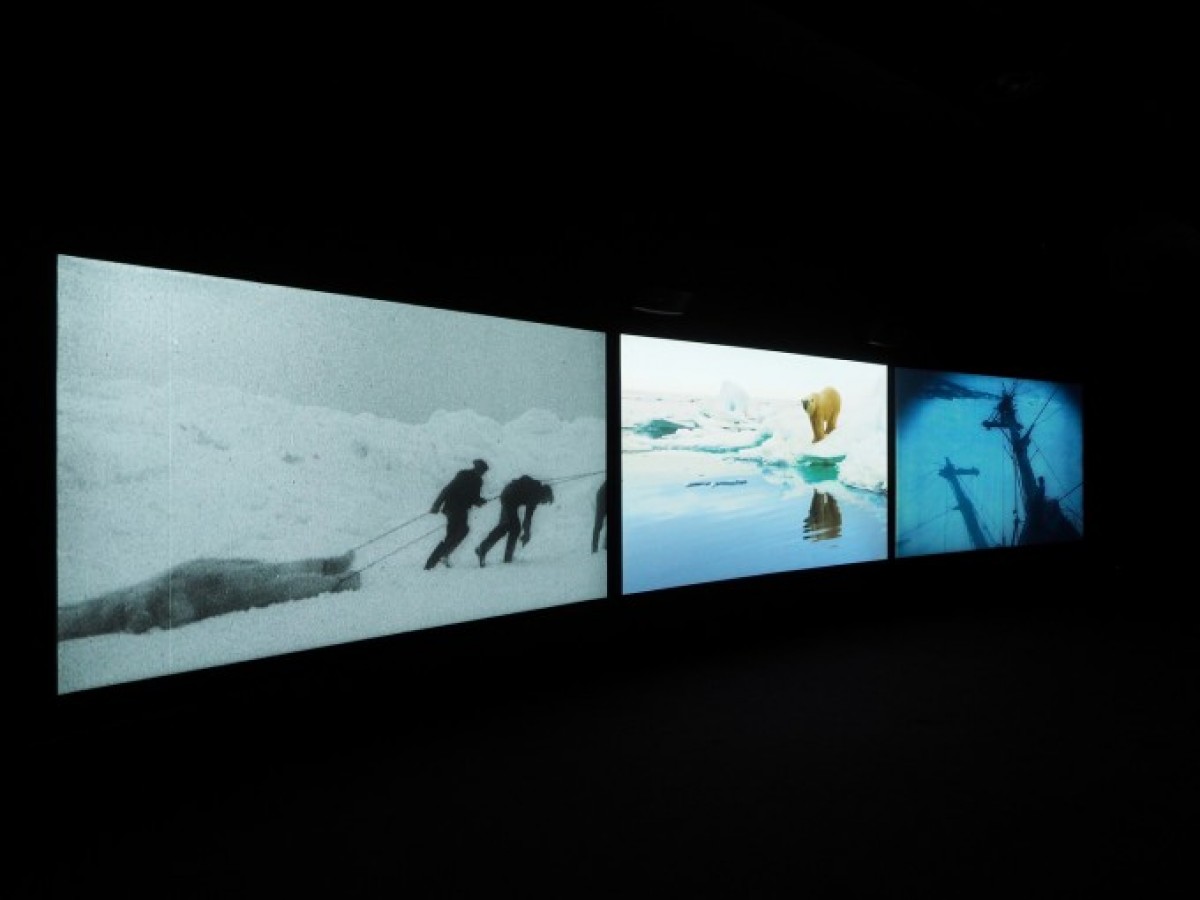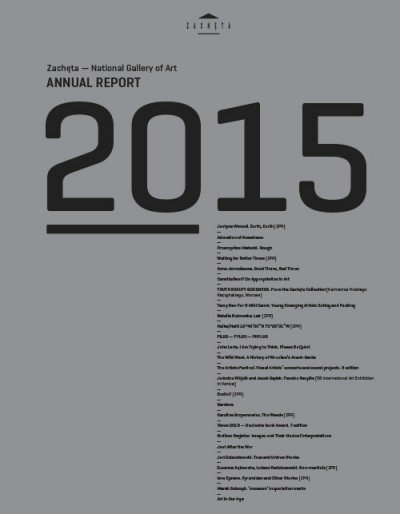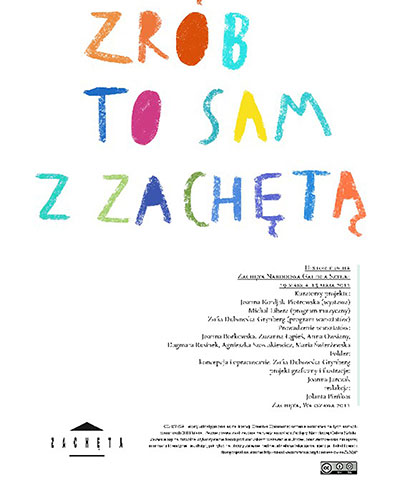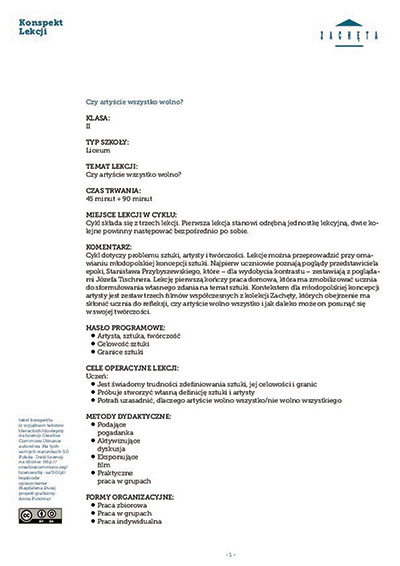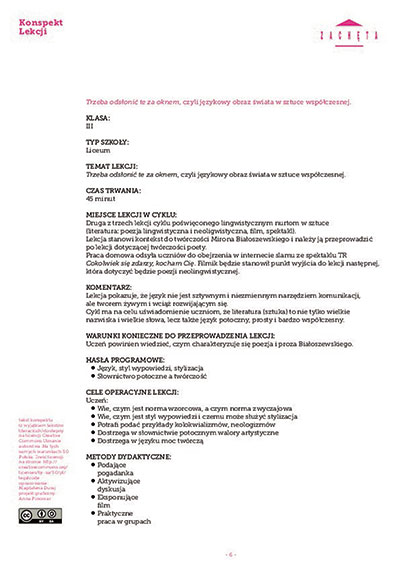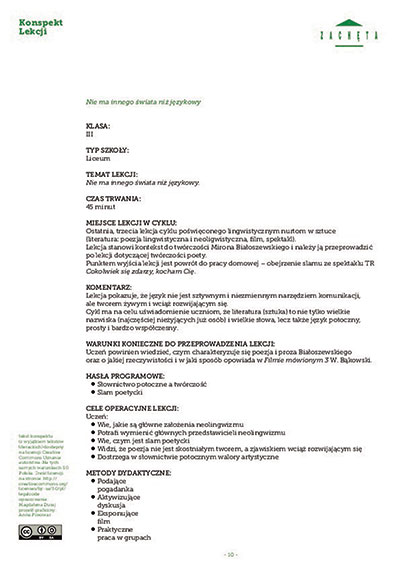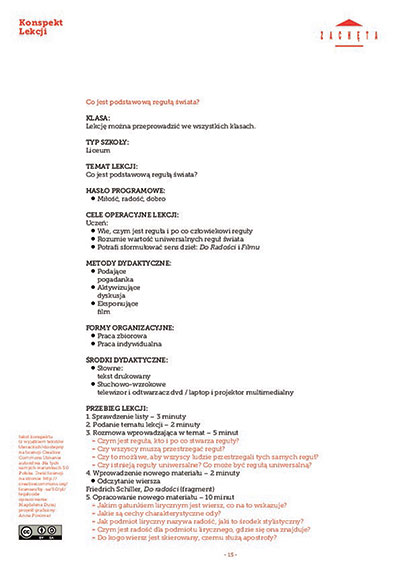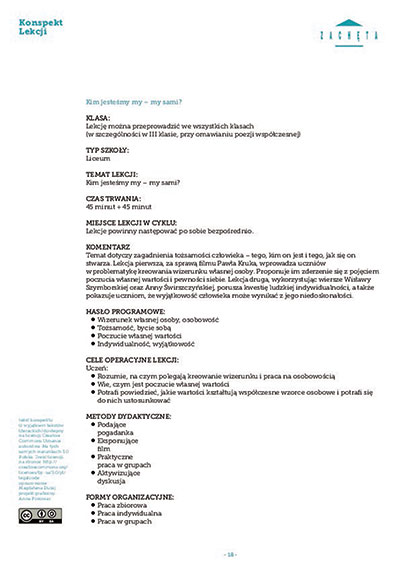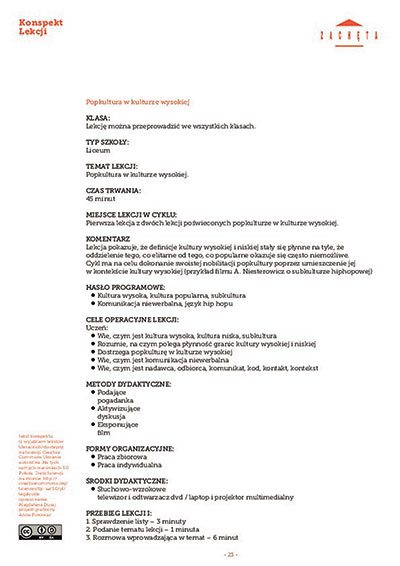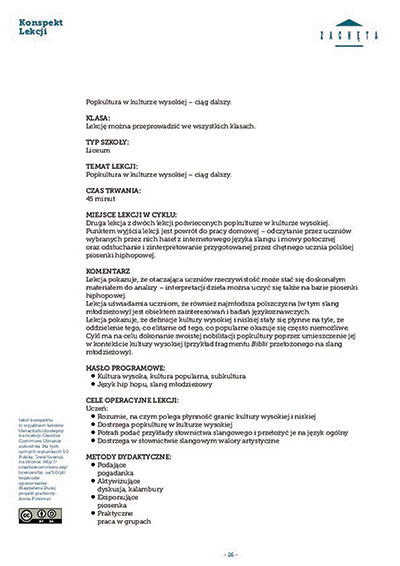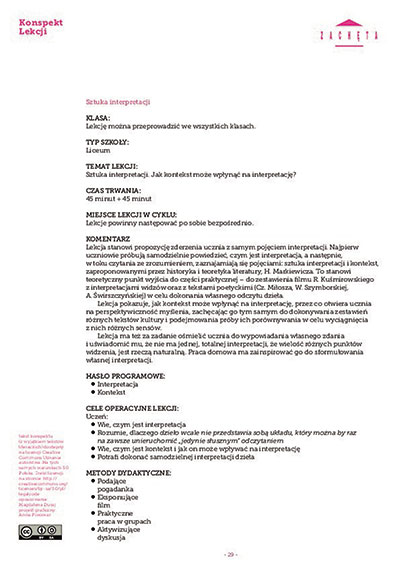Publikacja udostępniana jest na licencji Creative Commons.
Publication date: 02.03.2020
In his essay about the Merkabah by Anselm Kiefer, Harold Bloom cites the 16th century rabbi Judah Loew ben Bezalel from Prague (known as The Maharal), the same man who, according to legend, created an artificial man, Golem. The scholar reputedly said at one time that everything brought into existence within the six days of Creation needed improvement, so action. The more energetically we get down to work, the quicker we correct the opus of the Only God. In the same text, Blooms quotes the words uttered in Cain by Lord Byron, that before He designed our universe, God created many other worlds, which he later annihilated. It is, however, rather difficult to establish their number and find out if all of them were as equally flawed as ours.
When, during the most famous debate in the history of the world, held in Jerusalem in 33 A.D., one of the panellists implied that his kingdom was not of this world, what he thought about the one he was about to leave could be inferred. Thus, it is nowhere near innovative to feel that the work of God the Father is, in many respects, poorly edited and needs to be revised. This conviction was expressed with differing intensity over the next centuries by philosophers and thinkers of different traditions. A long time later, the Safed cabbalists, the Bauer brothers, Marx and Heidegger wrote about it. Finally, all of this got bogged down in the vague anticipations of prophets of doom and the more measurable predictions of 21st-century climatologists and, recently, also epidemiologists.
We don’t feel at home in this world – in this way you can encapsulate this ineradicable sense of discomfort taking its toll on humankind now, but dating back as far as antiquity. It was addressed by philosophers of pessimistic views, from Aristotle and Marcus Aurelius to Ludwig Klages, Horkheimer and Adorno. Till the moment when, in front of our eyes, they started to be replaced by experts in environmental devastation and the prophets of subsequent climate summits. Deep, sometimes brilliant intuitions gave in to exponential functions, numbers and the iron logic of charts.
In order to grasp the meaning of the notion of alienation, which underlies the basic massage of Maria Brewińska’s exhibition, it has to be presented in the appropriate context.
There are two ostensibly contradictory interpretations of it.
Firstly, it is a stiff perspective on alienation processes, understood as exclusion from nature’s circulation by the culture-forming attitude and technical civilisation. This can be best exemplified by Rousseau and Heidegger: the former seeks the sources of this exclusion in betraying the ideal of humanism, while the latter thinks that it is just humanism which promotes the treatment of nature as Gestell, another tool of human domination over the world. Nothing reflects better this concern of the philosopher than the watchword Nature in the service of man, because technique (whose synonym, o, sancta simplicitas, seemed to him a dam on the Rhine River) is construed here only as an extension, a surrogate of human haughty self-affirmation.
The second notion of alienation, which has dominated our modern understanding of social and civilisation processes, stems from the German Romantic and revolutionary tradition – the Jena school, Hegel, Feuerbach and Marx. The German word Entfremdung (estrangement), whose staggering career has lasted to the present day, moves us slightly away from the Latin term alienatio, one with very strong connotations of property law. It was mainly introduced to philosophical analysis by Hegel, who, as one of the first, drew our attention to the dialectical character of the unity of opposites and revealed a constructive relationship of contradictory moments of thoughts and reality. He showed alienation as a process. On the one hand, dramatic, but on the other hand, indispensable for the constitution of the human self. The highest form of this alienation is culture. It endows the individual with sense and reality; it is in its frames that we delight in the fruits of spirit; and at the same time its primary nature and substance is the spirit of the alienation of a natural being. To self-alienate is both the aim and existence of culture.It is not far from the pessimism of Sigmund Freud, who, right in the culture, found one of the main sources of suffering. If Hegelianism is a very attractive tool for describing reality today, it is because of its introducing the idea of identity’s dismantlement and ontological relativism to socio-historical consciousness.
Ludwig Feuerbach and Karl Marx focused on the alienating mechanism of religion and socio-economic relationships, pointing out its polymorphic character and general turbidity.
Giving God part of your being, says Feuerbach, deprives people of the ability to enter into relationships with their neighbours on equal terms. In this sense, religion is an institution against humanity, love, brotherhood and sisterhood (as we would add today). Man is a virtuoso of alienation – he devotes his best powers to the creation of a perfect image of God, at the same time turning Him, however, into an instance of violence, which takes possession of people. Therefore, faith has to be rebuilt by annihilating the God of religion, and founded on the relationship I-You (not excluding God as well).
Marx analyses the phenomenon of alienation, using an example of economic dependencies and showing how a proletarian gives part of his being to the product he manufactures but he cannot enjoy himself, because he cannot afford to buy it. By working and earning a living, he only retains and reproduces his own biological ability to manufacture another of the same product. This alienation increases when production becomes subject to sanctions imposed by anonymous political and legal institutions, maintaining the mechanism of depriving man of his own nature. Currently, this model of analysis has been adopted in fields not strictly connected with production, but social culture, corporations, social media and distribution of the dehumanising image of their content’s consumers.
The two notions of alienation described above, with all their historical complications, constitute a very interesting point of departure for sociologists, researchers and artists. At this point a question should be asked as to what extent mechanisms tearing man away from his “natural” bond with his own essence and other people, environment, reality and ancient values, determined to get out of the state of barbarity and wilderness, result from the growing degeneration of humanity, and to what extent are they a consequence of an in-born, immanent quality of human reason, which drives itself into a perpetual crisis? Is it a historically conditioned evolution of a desire for self-destruction, or rather an eternal need of a reason to negate its own roots, with antinomianism being part of its nature.
The “Alienations” exhibition comprises seven video pictures, recording dangers, in which dilemmas, already known earlier but now dramatically highlighted, are revived, fascinatingly placed in the history of visuality. Motifs of many narrations are combined here – from political headlines, media coverage and an ecological manifesto to the assessments, supported by a sociological analysis, of the inevitable decadence of the world and humankind. All these moments appear in front of us woven into the fabric of artistic expression, because – paradoxically – these are artists that are nowadays becoming an equal partner of scientists and experts in different academic disciplines.
The second part of the 20th century witnessed an incredible invasion of various forms of fascination with the phenomenon of alienation, the keystone of which was the global mythology of the Other, commenced by the serious analyses of Georges Bataille, Julia Kristeva and Bernhard Waldenfels. The science which tried to embrace this phenomenon was called xenology (Krzysztof Wodiczko used this term at some point of his artistic work to visually represent the problems of the exclusion and marginalisation of ethnic, sexual and cultural minorities, strongly accentuating the political character of the strategies of violence against Others). It seems that today we have reached a historic turning point. From the fascination with the Other, which took the form of what I call xenological tourism, the apotheosis of exoticism, the parody of theories, the gibberish of celebrities and theoretical scandal, changed into garrulousness and media confusion, we have suddenly moved to a defensive position against fears of progressing alienation. Before our eyes, alienation is becoming a threat, diagnosed from the vantage point of an impending crisis. It is accompanied by a flood of different pseudotheories, predicting an imaginary danger of the invasion of extraterrestrial civilisations, and the phenomenon of uncontrolled expansion of prophecies, supported by religious obscurantism and science-fiction productions, in which magic and witchcraft get the better of a common-sense assessment of reality. The time of collapse – one of many other, which the pandemic only announces – favours the incubation of swarms of intellectual water fleas, competing, in their diagnoses and pathetic pseudo-therapies, only with “The Watchtower”.
The alienations discussed by the curator of the exhibition in her introduction are a serious problem of vast amplitude. The ghosts described in the writings by Rousseau and Marx return – growing alienation of man from nature and other people, severance of social bonds, exploitation, devaluation of the canon of civil and employee rights, Capital’s greed, mounting concerns about environmental preservation. The fire in the title of the exhibition, referred to through the quotation from James Baldwin’s book, is not a problem of tomorrow. Fire is already smouldering and, by the time this text is published in the exhibition’s catalogue, we will probably be at another turning point. The question about the end of the world is no longer valid – it was yesterday. The Future is Gone.
On the fringes of the hysteria sweeping through the world, you can more and more often find disturbing visions of the upcoming era of artificial intelligence, which will not be, contrary to popular belief, callous machines programmed by man, but neurobiological organisms capable of self-powering, independent procreation and formation of their own communities, and perhaps even promoting codes of values unknown on the Earth so far. The question is if, in these constellations, man will be their partner, a part of the system, or some kind of nice and harmless, protected servant, a nursemaid of electronically produced offspring, a remote control or a laundress. A puppet in a house of mechanical dolls.
Will the time of extinction be the advent of a messianic era? And in what meaning of this word? Liberation from “humanism”, which recasts everything in its own distorted mould, the same humanism which at first orders man to conquer the Earth, and then, after centuries, when it is too late, sheds tears on the man-made disaster? Or maybe a final eradication of the worst of divine inventions, which is human civilisation?
Adrienne von Speyr, a Swiss mystic, whose heretical vision of the Cross and Hell is equally appealing and repellent, aptly describes the contemporary scene of the phenomenon of alienation. She writes about the creation, incarnation and redemption as “quarrels in the Holy Family”. She perceives Jesus as the Other, at odds with his Father; a redeemer roaming the hell of human sin’s totality; a prophet of the new world, not understood by his heavenly parent. The world, which he erroneously foretold and which suddenly changed from Holy Saturday’s hell unknown to theologians to the terrible corporate Easter Monday of the network proletariat. Julia Kristeva rightly described the conflict between the Father and the Son who – let’s not forget it – are a substantialist unity, as a key paradigm of alienation for the culture of the West. The problem of human alienation is that man does not inherit it from gods, but creates it alone as his own hell. Culture, civilisation and industrialism are only epiphanies of the fundamental dilemma – the delusion of identity, which drives reason to expansion, autocracy and self-destruction.
The “Alienations” exhibition consists of, as already said, seven motionless pictures, like seven seals of the apocalyptic visions of the forthcoming world. The faster we open a sealed envelope with an ominous advice note inside, the better. However, avoiding the receipt of registered letters has become our second nature. Populists, who talk bullshit and ignore danger for the sake of the rabble, try to convince us of the affectation of ecologists and the exaggeration of pessimists. Nevertheless, the world is teetering on the brink of disaster, whether politicians like it or not.
Three works, in my opinion most important and essential for the understanding of the whole exhibition, are Vertigo Sea by John Akomfrah, Grosse Fatigue by Camille Henrot, and Les Indes Galantes by Clément Cogitore, which crowns the series of installations.
Vertigo Sea is a monumental triptych addressing the issues of postcolonialism, ecology and the migrant crisis. The combination of the visual descriptions of contemporary alienations with the aesthetics of representation, inherited from Romanticism (German, of course), is very interesting. It is especially important because just at the turn of the nineteenth century the main directions of the first critical analysis of the phenomenon of alienation, fundamental for the future of European thought, crystallised. The classical element of water (it is becoming dramatically scarce on the Earth), so fascinatingly rendered in videos, brings to my mind a passionate call by Johann Gottfried Herder (a pioneer of the German Romantic revolt), transformed one hundred years later by Friedrich Nietzsche into manifest of a new (joyful) wisdom: Aboard ship! ye philosophers! Since that time, flotillas of ships, symbols of colonial conquests and the transport of a cheap slave workforce, have become a vehicle for exploring other cultures and a tool for broadening consciousness, as well as rejecting the heritage of expansion and violence. It was Herder, Goethe, Humboldt and the brothers Schlegel who gave the world the gift of their travels, made people acquainted with Eastern rituals and previously unknown languages (in particular Chinese and Sanskrit), and allowed them to combine it all with the tradition of West European vitalism. And revive the early medieval paradigm of culture as an art of translation.
The tragedy of thousands of migrants, drowning in the deep when trying to escape from poverty and mortal danger, is a bitter irony and unintentional (although unavoidable, as it seems) consequence of these fascinations with the ocean. The fascinations which also resulted in greedy fishing, disrupting the ecological balance, destruction of marine species, and relentless exploitation of natural resources to produce consumer goods. It is an appealing image of the severance of natural bonds, a repellent visual essay about the vile and blindness of market decision makers – a horrifying review of the cataract and short-sightedness brought by the progress of civilisation. And an enlightening lesson on how we ourselves have become slaves of Capital's idols.
Grosse Fatigue moves us to a slightly different dimension, still, however, correlated with the field of alienation. It is an intriguing picture of the verbosity of on-line encyclopaedias, the babble of browser tabs, the mixture of mythology, knowledge and pseudo-science of the beginning of our world, in which our reason and ability to separate the wheat from the chaff is lost. This wonderful film, made up of sequential, fleeting visual shortcuts and snippets of information, causes the chronic weakness of viewer’s perception, while its impulsive, hysterical rhythm perfectly conveys the atmosphere of confusion, which is slowly gripping our minds. The illusion of the world of colourful pictures, in which knowledge blends together with Wikipedia nonsense and random links, treacherously lures us by fulfilling our infantile desire for immediate satisfaction. We live in a world turned upside down, in which we feel comfortable in the short run, but which tires us out and fills us with melancholy in the long run.
And finally, there is Les Indes Galantes, linking everything together. The curator chose it as a coda not without reason. It is the only optimistic message in the upsetting sequence of other images. Based on neocolonial reminiscences, dealing with historical problems, using the motif of the famous opéra-ballet by Jean-Philippe Rameau (the same whose cousin appeared in Diderot’s dialogue as caricature of reason, full of platitudes) is an apotheosis of dance as a revolt and liberation. It is also a praise of interracial tolerance, energy radiating from the rhythm and vitality of people who have overcome cultural barriers. If Nietzsche was right, saying that the most important truths about the world, desperately sought by us, are the truths created for our feet, “truths to which we can dance”, this film can convince us of it. Today – I do not pretend that I foresaw it – this dance resembles the riots in Minneapolis, Washington and New York.
The “Black Message” of the whole exhibition tells us more than all the symposia and panels taken together, invalidating the chaos of belated diagnoses and the muddle of ad hoc solutions.
What is alienation? Is it departing from ourselves, removing the tissue of the world, with which we can no longer communicate, tearing off everything what reminds us of our common origin? Undoubtedly it is all of this, but also, first and foremost, something which we still do not know. This game is just beginning, and nobody can predict what will be next.
Our pain over nature, once united with us but now leaving us alone, is a phantom pain. It hurts us in the place where there has been nothing for a long time.
I remember showing Andrzej Leder around the exhibition by Maria Brewińska at Warsaw’s Zachęta in the summer last year. We watched, talked a bit, pushing our way through the crowd visitors in semi-darkness. At some point Andrzej asked me: “I feel the climate and the language. But this is something better understood by my daughter’s generation because they will have to live in this world. Actually, what's this exhibition about?” I pondered for a while and answered: “I don’t know, maybe about our screwing something up.”
Andrzej Wajs
-
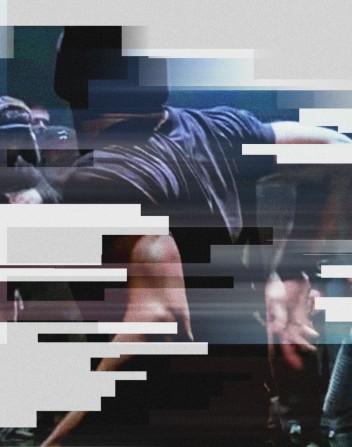 13.07 – 29.09.2019Alienations or The Fire Next Time
13.07 – 29.09.2019Alienations or The Fire Next TimeThe exhibition consists of seven films by outstanding and renowned artists; some of them are presented for the first time. They show in different ways the condition of people, the Earth, what we are losing and what we desire, the effects of the different forms of alienation that we experience globally today. They make us aware of the causes of alienation, the mechanisms of destructive human behaviour, recalling historical and contemporary events that affect the state of today’s world.
Zachęta – National Gallery of ArtZachęta
